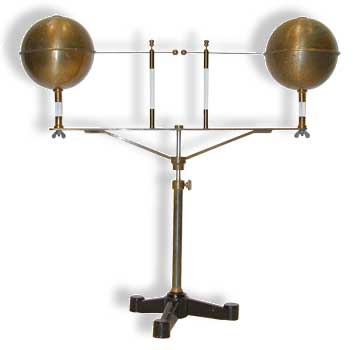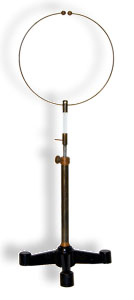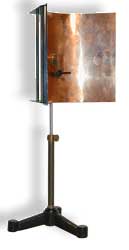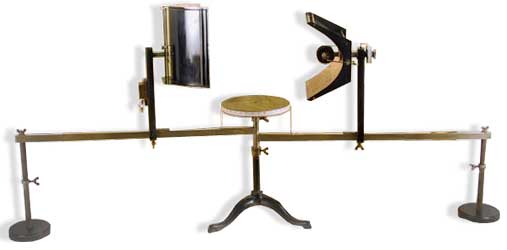| Contact |
| Back | Next | Home |
The
Beginnings of Radio
1880 - 1900
|
There was major scientific interest in electricity throughout the eighteenth and nineteenth centuries, and much progress was made. During the 1700's interest focused on static electricity, and the science consisted mostly of various experiments with electrical phenomena followed by qualitative theories attempting to explain the results. but in 1800, the invention of the battery by Allesandro Volta sparked a new electrical revolution, marked by a new generation of quantitative scientists such as André-Marie Ampère , Joseph Henry, Georg Ohm, and Michael Faraday. Faraday was the first to propose the concept of an electromagnetic field - lines of force which spread out in all directions to fill space, and to affect matter within that space.15 It was James Clerk Maxwell, however, who built the theoretical bridge from electricity to radio. Intrigued by Faraday's work, Maxwell developed a set of equations to describe mathematically how a changing magnetic field produced an electric field (electrical induction). He discovered that the opposite was also true, and that changing magnetic and electric fields in space produced electromagnetic waves. He showed how these waves traveled at the speed of light, and that in fact, light was just another form of electromagnetic wave. Maxwell presented his analysis in 1873, in the two volume books entitled "A Treatise on Electricity and Magnetism." Little progress toward radio was made until 6 years later when the Prussian Academy of science offered an award to "establish experimentally any relationship between electromagnetic forces and the dielectric polarization of insulators." A bright young professor of physics at the Engineering College in Karlsruhe, Germany, named Heinrich Hertz picked up the challenge and began a series of experiments. Two pieces similar to the apparatus Hertz used are shown in Figures 1 and 2 below. The Spark gap in figure 1 was connected to an induction coil. The "resonator" (Fig. 2) was placed on a bench nearby. During the course of his work, Hertz noticed that when the induction coil was activated, a small spark appeared in the resonator. Since the resonator had no physical connection to the induction coil or spark gap Hertz knew he was witnessing a new phenomenon. Hertz thus confirmed Maxwell's theory. Through a series of ingenious experiments he went on to confirm that this new phenomena were indeed waves, they traveled at the speed of light, and that the waves could be reflected, refracted and polarized, the same as light waves. He was also able to calculate their wavelength and frequency. Hertz's discovery led to a groundswell of interest by many people, including a young Italian named Guglielmo Marconi. |
|
|
|
||
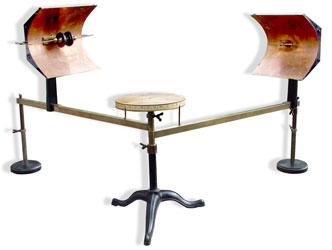
|
|||
|
Parabolic Transmitter and Receiver Utilizing Righi spark gap and Branly Coherer I believe this is to be a replica made in the 1920's of a very early Marconi experimental set built in the 1890's. |
Early Transmitter Tuner FERDINAND ERNECKE-BERLIN Early 20th century |
||
|
Bing Coherer/Decoherer (receiver) with Rhumkorff Transmitter 1906 |
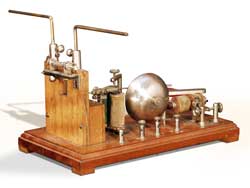 Klicnik Coherer Receiver (German) c. 1900 |
||
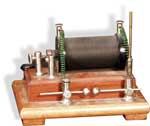 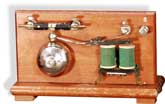 Nimelior Coherer Transmitter and Receiver c. 1900 |
Max Kohl Spark Transmitter (Bose design) and Coherer Receiver (German) 1900 |
||
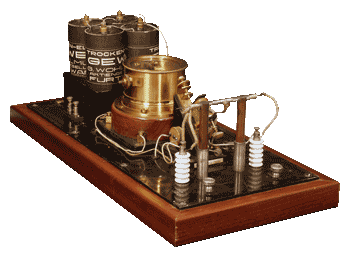 Meiser & Mertig Coherer Receiver (German) c. 1900 |
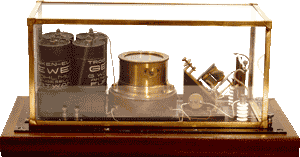 Meiser & Mertig Coherer Receiver With cover |
||
|
Early Spark Gap Apparatus c. 1900 |
"Singing Condenser" (Italian) 1872
This rare device
consists of a primitive carbon microphone, an induction coil and a
condenser. It roused great curiosity in the early days of the telephone
because the sounds came from a flat condenser made of sheets of tin and
paper. The famous Italian physician Augusto Righi explained that every
charge and discharge of the condenser produces a changing of density of
the air on the frameworks surface, producing sound waves. Today, the
same technology is used in the production of high quality electrostatic
loudspeakers. |
||
This piece isn't really related to the "beginnings of radio" but it is such an unusual and beautiful device I didn't want to bury it further back in the website with the other land telegraph apparatus. Each letter of the alphabet is printed around the top edge, and has a corresponding coil of wire. A character is sent by passing a current through the corresponding coil, creating a magnetic field which turns the needle to indicate which character is being sent. This device is one of a generation of telegraph devices invented before the development of Morse code. The response of the needle is very slow and each alphabetic character requires a separate wire between the transmitter and receiver, or 26 wires in all. "Needles" to say, (sorry) these early telegraphs were not very practical and saw little commercial use. |
|||
| Contact |
| Back | Next | Home |
